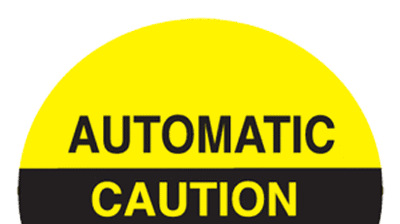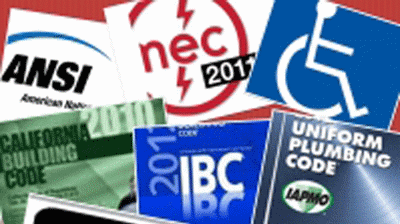THE UPS AND DOWNS OF PARKING LOT CONTROL ARMS
Download PDF of this article here
By Michael Panish, Door & Gate Expert Witness
THE UPS AND DOWNS OF PARKING LOT CONTROL ARMS - What every attorney needs to know about how they function, why they fail, and why someone was injured. Who is at fault, who is to blame, and what the industry standards are that affect the claim? By Michael Panish

My office is contacted many times a month regarding a parking lot control arm or barrier gate injury of some sort. These terms are generally interchangeable; however, some standards do not use the term control arm, only barrier arm. Usually, the attorney starts by explaining that the plaintiff was hit by a descending parking lot arm without any advance warning. Sometimes the injured party is riding a motorcycle, sometimes walking as a pedestrian under the control arm. In other claims the gate control arm does not fully cycle open before returning to the horizontal position. There are also cases where the gate appears to have been left in an open position, turned off, and is remaining in the upright position for extended periods of time and suddenly descends just as a pedestrian begins to pass under it. There are numerous variations of the same type of accident, but there are big differences in who the responsible party is for the cause of injury. Some of the first questions asked pertain to how the device works, and why the control arm did not detect the person as they walked through the driveway.
FULLY AUTOMATED OR ATTENDED, BOTH SHARE SOME CHARACTERISTICS
Manufacturers of most control arm gates build their devices to activate in one of two different ways. Fully automated by remote stimulus and/or manually controlled by a parking lot attendant.
Many parking lot control arms are activated when a driver pulls up to a parking lot gate in a vehicle. As the vehicle arrives, an electronic signal is sent to the parking control arm mechanism due to the detection of that vehicles large metallic presence interacting with an in-ground magnetic field. This
in- ground magnetic field is created from buried wires known in the trade as an induction loop. The signal generated from this “activation or approach magnetic induction flux loop” often is connected to a ticket printing device. This piece of equipment is commonly referred to as a “Ticket Spitter”. The “Spitter” issues a ticket, usually for single vehicle access prior to activating the control arm gate mechanism causing the arm to raise. An alternative method to get the control arm raised requires a driver to reach out of the car and push a button to receive a parking lot access ticket from the “Spitter”. (In that mode of operation, it is probable that there is no magnetic loop in place.) In either case, once the ticket is taken by the driver, the “Spitter” sends a control signal to the gate arm mechanism, and the arm is supposed to raise, generally for a single vehicle to control access to the parking lot.
As the vehicle transitions from the approach location where the ticket is issued, once the control arm raises, there is usually a functioning magnetic flux or induction “Safety Loop” located under the control arm swing location which provides protection for a vehicle until it has cleared the “Zone of Danger” underneath the active control arm. The control arm may also be kept in the open position by a timer that holds the gate arm up for a predetermined time prior to closing. Using a timer function in place of an in-ground magnetic loop is risky, as vehicles may not clear the opening, or another vehicle can attempt to gain access without receiving a usage ticket. Older, non-current standard compliant installations have been seen without any consistency of design or operational function.
There are multiple installation variables that can alter the basic loop positions and quantities, but most basic systems operate as described above using at least two control loops. One underneath the control arm, and one egress or approach loop. In some installations, all three loops will be present. This triple looped system offers the most comprehensive safety for a vehicle, NOT A PEDESTRIAN!
MANUAL VERSIONS OF PARKING LOT CONTROL ARMS
A parking lot attendant, usually positioned inside an adjacent booth, has a control switch that activates the parking lot control arm. The attendant has a switch that raises the arm, lowers the arm, and keeps the arm inactive, either up or down. Some manually controlled arms also have magnetic induction loops connected to the parking lot control arm when the parking lot is unmanned after hours, in which case, the arm should function in the fully automatic mode, as described above.
CONTROL ARMS ARE WEIGHT ACTIVATED, RIGHT?
Contrary to popular belief, most parking lot control arms are activated due to a change in a magnetic field which is generated by twisted energized wires positioned below the adjacent pavement of the control arm. Modern control arms are not usually controlled by pneumatic pressure like an old-fashioned gas station bell hose. It is unlikely that the weight of a vehicle or a pedestrian walking underneath the arm will stop an active control arm. Modern parking control arms are triggered by a change in the magnetic induction loop return. Modern induction loops are manufactured from a relatively light gauge of wire, placed in a rectangular shape that is calibrated and sized to detect a change in the magnetic field when a metallic object such as a vehicle enters or covers that field.
Many attorneys insist to me during their initial call that a pedestrian walked next to a control arm, activated the arm due to their client’s weight, and the arm failed to remain open as they walked under the arm. This scenario is generally incorrect. Weight of a vehicle, or weight of a pedestrian cannot activate most modern parking control arms. A trigger of a control arm or activation of a street traffic light due to weight has not been in practice for many years. It is highly unlikely that a pressure pad sensitive to weight is ever controlling a parking lot arm today.
UL 325/ASTM F2200
There are several standards that are used to design and install parking control/barrier arm devices. In the most basic sense, UL 325 (Underwriters Laboratories) in conjunction with ASTM F2200 (American Society of Testing Materials) as well as other trade organizations have compiled standards that are designed to make a control/barrier arm installation safe and user friendly. Most of the regulations that are referenced in these standards have been adopted and in common trade practice and usage since the year 2000. There are numerous revisions of these standards, and industry best practices for service providers and installers should be to bring any of these past installed products up to date with the latest revision of the standards for entrapment and function.
A UL 325 COMPLIANT INSTALLATION
A UL 325 compliant barrier arm or parking control arm installation requires several conditions to be met. The parking control arm mechanism is generally installed atop a concrete island (not a UL requirement). All conduits and control circuits are routed into the base of the control arm mechanism through this elevated platform. This is not always the observed situation; however, it seems to be the most encountered condition as the elevated platform provides protection from vehicle impact for the control arm housing. When this island is placed by a concrete contractor, it is the perfect time for the facility to install a dedicated pedestrian walkway.
This dedicated pedestrian walkway must be away from the “danger zone” of the active control arm. This dedicated pathway is one of the most important factors to having a UL 325 compliant installation. Another significant safety device required for a UL 325 compliant installation is blatant painted warnings on the pavement located adjacent to both sides (ingress and egress) of the control arm. For instance: “Not a Pedestrian Walkway” or “Motor Vehicles Only” along with bright stripes and designs to draw the attention of a pedestrian to indicate danger prior to coming into the “danger zone”. Signage is also required, on the control arm itself, the cabinet that houses the activation equipment, and on a placard in front of the control arm equipment.
PEDESTRIAN SIGNAGE, NOT ALWAYS EFFECTIVE
I have observed for many years that pedestrians are often walking while distracted by their cell phones, other people they are engaged in conversation with, or low lighting conditions. Although a UL requirement for a compliant installation is having a warning sign placed in several areas adjacent to and attached to the control arm, that warning is often unseen for many reasons. Pedestrians often look to the location that they are planning to reach without seeing their immediate surroundings. When this occurs, any warning signage has no value to them. A control arm sign that is attached to a vertically elevated arm is out of the field of view for a pedestrian in most cases so that warning label is ineffective. A distracted pedestrian is as likely to walk off a curb in front of oncoming traffic or walk under a raised parking control arm without realizing that the danger exists. Blatant pavement signage has also been ignored by distracted pedestrians focused on getting to where they want to go.
WHO IS AT FAULT?
There are a variety of cases where a parking lot control arm has malfunctioned due to a complete lack of maintenance awareness. Most manufacturers suggest parking lot control arms should be inspected and evaluated for function by a professional service provider at least once a year. This interval inspection routine is questionable in a parking area with high usage of the control arm. In a case of continual usage, a professional service provider should be in place to inspect the device every quarter. Usually, some malfunction occurs to a control arm function that requires professional visits more frequently than every 3 or 4 months in a high usage installation.
Sometimes property management or an owner employs a maintenance person to make repairs. This can be problematic, as that maintenance person may not have adequate skills or training as to how to properly inspect the functions of the control arm mechanism and related systems correctly. In other low usage areas, where the arm is either occasionally used, unused and left in an open condition, or there is minimal parking lot activity, property owners never get their control arms serviced. They are unaware of the need for service, feel that the arm is operating correctly when it is used, or just do not want to expense the services of a professional due to budgetary constraints or an ignorance of how the device functions.
Most owners of parking control lot arms do not understand or have the skills to properly check all functions of the arm control mechanism. They may be capable of replacing a broken arm component when damaged by a vehicle, but rarely understand the actual control arm electronic requirements. When a competent, qualified professional service provider is used to make proactive inspections of a parking control arm, there are numerous tests and electronic evaluations that are made with dedicated service equipment that the average control arm owner would not possess.
One of the most basic critical evaluations to ensure that a parking control arm is properly functioning involves checking the resistance capacity of the in-ground magnetic flux loops. These loops are one of the primary controls for avoiding vehicular/arm impact collisions. There is an electronic meter known as a “megohm meter” or “meggar” that checks the condition of the in-ground loop insulation material of all system loops. It measures millions of ohms of resistance by placing a signal onto the flux loop when tested. The unbroken condition of the insulation that is the outside coating of these in ground wires is essential to have a properly functioning flux loop.
Electrical leakage to the surrounding ground due to partial loss of the protective insulation creates false imaging to the controls of the parking arm equipment. The insulation of these flux wire loops has an expected life. This is due to corrosive aspects of the material that the wires are encased in. Concrete, asphalt, various cement, sands and gravel all have corrosive components to their chemical composition. These acids can affect the lifetime of the flux wire insulation. Depending upon how much water leaches through the pavement, these flux wires will eventually be exposed to chemicals that will break down the insulation protection that is required. When that insulation breakdown finally happens, the operation of the magnetic flux loop is inconsistent and often becomes a danger to vehicles of all kinds (cars, trucks, motorcycles, bicycles, trailers, etc.) using the control arm.
Defective operation of parking lot control systems has been frequently observed following flooding due to driven rains or adjacent sprinkler systems. In several past cases, service providers and owners that failed to take critical tests to determine insulation quality of magnetic loops have been responsible for damage caused as a result of those unknown wire conditions. In some claims, the service provider was aware that the loops were not functioning up to specifications of the loop manufacturer yet failed to take any proactive action to have them replaced, or minimally alert the owner of the arm that the condition existed. To save money, some service providers fabricate their own loops for these installations. When that is the case, the service provider needs to regularly verify the condition of the loops to make certain that the performance is as required.
ADDING ADDITIONAL SAFETY FEATURES
It is usually a goal to make a product that is as safe as is possible for all users. The UL 325 standards attempt to keep current with technological advances but are not always up to date. Basic requirements as described above do make control arms reasonably safe, but there are additional safety devices that can be added to most parking control systems.
- Cross threshold optical sensor beams. These beams function in the same way that a common residential automatic garage door bottom beam sensor works. They provide an additional protection to both vehicles and pedestrians as they stop the control arm from descending when the beam is obstructed. To be effective, they need to be properly positioned and in enough quantity.
- Audible alarms are being installed to alert pedestrians and drivers in proximity to the control arm that it is about to descend.
- Visible alarms that provide strobe or flashing light action alert pedestrians and drivers that the control arm is about to descend.
- Contact safety switches attached to the bottom edge of a parking control arm cause the descending arm to reverse when 10 pounds of force from an obstruction occurs.
These added safety devices are not part of any standard requirement but are relatively inexpensive to add to a control arm system and tend to be more effective in warning pedestrians that something is about to happen. Both alarms begin working a few seconds before any activation movement of the control arm starts. A properly positioned beam or beams can be effective in stopping the descent of a control arm when a pedestrian is obstructing the beam but is not fully reliable due to user interactions. It is best practice to avoid having any pedestrian walk under the pathway of a control arm.
THE IMPORTANCE OF KNOWING THE ACTIVE CONDITION OF ALL MAGNETIC LOOPS
Many motorcycle injuries from parking control arms have occurred as a direct result of magnetic loop degeneration. Properly operating control loops should have enough sensitivity to “notice” most metallic objects. I have been able to test magnetic fields for gates and control arms using a one-foot square piece of sheet steel with positive results that have activated the devices. Cars and trucks obviously have larger footprints than a motorcycle, scooter or bicycle, but if the loops are sensitive enough and the module that controls those loops is properly adjusted, it is not unreasonable to get a big enough change in the magnetic field to trigger the operator mechanism. Unless there are specific access and egress points for motorcycles and other two wheeled conveyances, most riders will expect that a control arm will react to their rides. It is critically important to have competent professional service providers evaluate control arm systems on a regular basis. Changes to sensitivity of the magnetic fields that can occur suddenly create problems resulting in cosmetic damage to cars but can cause catastrophic dangerous conditions for two wheeled vehicles. Motorcycle accidents with control arms are particularly dangerous when the safety loops that are positioned under the control arm fail or work intermittently. A rider will gain access, the control arm will lift, and without warning the control arm will descend into the face or on top of the head of the rider leading to potentially severe injuries. It is a reasonable expectation on the part of a motorcycle operator that the arm will remain open and the in-ground loops will detect the presence of a motorcycle. Dangerous conditions that exist as a result of deferred or non-existent maintenance of parking control arms have created many motorcycle rider impact injury claims.
VARIETY OF OBLIGATIONS ON ALL PARTIES
THE OWNERS OBLIGATIONS
When there is no proactive maintenance of any device or piece of equipment in a facility the owner is negligent for failing to make the effort to ensure that the property will be safe for all invitees. Failing to employ competent professional service providers due to cost, ignorance, laziness or stupidity is negligent. Having properly maintained and properly operating equipment is responsible and meets the standard of care expected of an owner that invites the public on to the property. Having a proactive plan to provide inspections and maintenance of all equipment is responsible and diligent. If the professional service provider has not met the standard of care, the owner may ultimately have the responsibility for the defective condition of the control arm. Whether or not there is an indemnification policy between the service provider and owner can determine who is financially responsible for the injury claim. If the owner has been informed of operational or functional deficiencies by others and has refused to upgrade or make the control arm standard compliant, it is more probable than not that the owner will become a responsible party.
A SERVICE PROVIDERS OBLIGATIONS
If a professional service provider does not make the property owner aware of changes in standards or advise the owner of possible safety upgrades, that professional is not acting up to industry expectations. The service provider is also not taking the opportunity for increased sales revenues derived from making those suggestions. If a service provider has offered limited services to an owner (such as an on-call / as-needed basis), it is hard to place the blame on the service provider that was just providing specific work. It is still recommended that all deficiencies in an operating control arm system be identified, specified, and described so that the service provider can transfer the liability onto the owner of the now non-compliant control arm.
When a professional service provider installs a parking control arm in a non-compliant installation (for example there is no dedicated walkway or signage), the obligations for that deficiency depend upon the communication and working relationship with the owner of the property. There are several different scenarios that determine the responsible parties for the non-compliant conditions.
- Was the service provider only called upon to install a specific product?
- Was the service provider limited by the owner of the property to only do a specified job?
- Did the service provider make the owner aware of the deficiencies of the installation prior to, during or after the work was performed?
- Did the service provider attempt to make the installation current standard compliant, but was told not to?
- What portion of the installation was the service provider involved with? For example, the service provider was contracted by a general contractor and told to specifically provide a portion of the products required to make the installation compliant. The representations made by the general contractor was that the general would place all signs when the project was turned over to the owner, the general would have appropriate pavement warnings painted and placed when the paving was completed, and the general would install a dedicated walk way for pedestrians at a later date.
If the service provider acted in a trade appropriate manner, fulfilled all duties and obligations informing the owner or management of the non-compliant conditions encountered, that service provider has met the industry standard of care. In that case, the service provider is not responsible for a non- compliant control arm installation.
PEDESTRIANS INVOLVED IN A PARKING CONTROL ARM INJURY
WHAT WERE THE CIRCUMSTANCES?
This condition has been seen so many times that multiple injuries were caused in the exact same way. In several past claims, a pedestrian was essentially forced to walk under a parking control arm because there was no other way to exit the lot or garage space. There was no dedicated pedestrian walkway, no openings in a fence, no indicated paths for people to exit, no special stairways or other means of egress, and in those cases, the control arm was unavoidable. In other claims, a remotely operated control arm, that was activated by a guard in an adjacent hut came down upon several pedestrians due to the guard being careless. The gate was routinely in an upright position, the guard never meant to have the gate close upon the pedestrians, yet the injury took place as a direct result of the guard’s negligence.
ACTUAL CASES OF PEDESTRIANS BEING STRUCK BY PARKING CONTROL ARMS
A group of pedestrians walking into a concert venue walked under a control arm, which came down just as they walked under it. There was plenty of space on either side of the control arm, but there was no signage or painted warnings on the pavement showing where the arm could come down.
A pedestrian going to work in a hospital, caused her own injury. She watched as a car went through the control arm entry point and did not realize that the gate would close upon her. In her deposition statements she said she thought that the arm would stay up because she had seen other people walk through the same opening in the past without the arm descending. There was a dedicated walkway a few feet away from where this incident occurred, going through the vehicle path was a shortcut that saved a few steps and caused her major injury.
Tenant of an apartment complex gets hit with control arm gate after helping a neighbor gain access when the neighbor had forgotten her card key access pass. The injured party stood adjacent to the control arm, swiped her access card, watched her friend drive through the opening and then without thought proceeded into the lot following the car. Once the car cleared the magnetic loops, the arm descended as designed, only it struck the tenant, knocking her out only seconds after her good deed.
INTENDED USE OF CONTROL ARMS
Control arms are designed for restricting the flow of vehicles into or out of a location that desires regulation of traffic. The equipment functions based upon activation signals received as described above. Access points that have control arms are not intended for pedestrian traffic at any time. While most vehicles are metallic, most pedestrians are non-metallic. The machines that operate these control arms are dumb robots without any capabilities of intervention in the event of a non- conforming use. A pedestrian attempting to walk through a parking control arm location is a non- conforming use, and there must be some common sense exercised when assessing an interaction with any robotic machine.
PROPERTY OWNER OR PROPERTY MANAGER RESPONSIBILITIES
All owners that have public, commercial, or residential community properties can expect usage by thousands of different people. If proactive maintenance and evaluation of the location setting as well as the condition of the equipment that people interact with is made routinely, an owner can take the needed steps to keep the property in a reasonably safe condition. An owner should enlist the services of qualified and competent service providers to make certain that all access control arms are properly functioning, and the site is totally compliant. If an owner takes responsibility and hires professional service providers to make a property fully compliant, that owner has met his obligations to all invitees of the property. Failing to proactively evaluate a potentially dangerous condition is negligent. Maintenance saves money in the long run. Keeping equipment of all kinds in good condition is responsible and indicates good ownership. Safety to all invitees should be of prime importance to a concerned owner.
TERMS YOU SHOULD KNOW
Magnetic induction flux loop: A wire of specific size and design placed below the pavement surface to create a magnetic field which is altered when a metal object (vehicle) is in proximity or on top of the wire field.
Ticket Spitter: A printing device used to dispense parking tickets to patrons of a parking lot. Manual (push button by user) or automatic (triggered by presence of vehicle on top of magnetic loop in ground), records date and time of entry onto a paper ticket and then when removed from the slot activates a control arm mechanism to gain access into the lot.
Control arm device: All electronic and mechanical equipment combined to allow a gate arm to raise and lower.
Approach loop: Magnetic loop placed in ground to trigger activation of a control device.
Safety Loop: Magnetic loop placed directly under the path of a parking control arm to protect vehicles from impact by a descending gate arm when the zone is occupied by a vehicle.
Egress loop: Magnetic loop placed in ground to hold a control device in the open position until the area can be cleared. Usually in place in high traffic or cross traffic locations.
Megohm meter (Megger): An electronic meter designed to determine resistance in millions of ohms, relevant to this article, checking for leakage due to the breaking down of insulation on in ground magnetic flux loop wires used to control parking control arm actions.
Zone of Danger: The area immediately under the path of a descending parking control arm and any immediate area where a pedestrian could be struck by a descending arm without notice.
SUMMARY
Parking Control arm injuries occur frequently. These injuries are often the result of a deferred or non-standard installation or maintenance protocol. They occur equally to standard compliant installations when pedestrians just do not pay enough attention to their surroundings.
For further information regarding requirements for parking control arms, and other access injury issues such as overhead and sliding gates and control points that use in ground control loops, contact Sharon at Michael Panish’s office 888 902-4272, and visit www.ConstructionWitness.com. If you would like to discuss a case with Mr. Panish, he is retained evenly for plaintiff and defense claims and can assist you. He has been retained on over 2500 cases to date since the year 2000 and has been the retained expert on parking control arm cases across the country. Mr. Panish has been called upon to discuss installation conditions prior to new construction and help the owner determine the best way to accomplish the desired goals.
Other Gate & Fence Articles by Michael Panish
GATE & FENCE - Accidents and Injuries
Malfunctioning gates and fences can cause catastrophic and traumatic bodily injury and death. Parking garage gates, pool fences, property fences, drop down doors. By Michael Panish
AUTOMATIC ENTRY GATES - Personal Injury & Damage Claims
A comprehensive look into automated entry gates, gate injuries, gate maintenance, and gate service providers. How to determine responsibility of involved parties and understand what leads to a claim.By Michael Panish
MANUAL SWING BARRIER GATE INJURIES
More dangerous than you would think. Why have so many injuries occurred? What are the reasons why these innocuous common devices have become life changing instruments of despair? By Michael Panish



